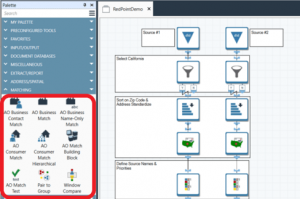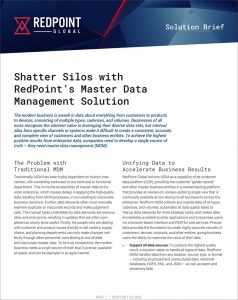 Redpoint Data Management (RPDM) is a feature rich, enterprise data management application that functions across both traditional and Big Data architectures all within a single interface. This and other key features and capabilities are why the Redpoint solution consistently ranks high in customer surveys for processing speed, data quality, data integration, and ease of use. Yet even with a single, intuitive interface that makes the design and execution of data management processes easy and fast, there is still a learning curve.
Redpoint Data Management (RPDM) is a feature rich, enterprise data management application that functions across both traditional and Big Data architectures all within a single interface. This and other key features and capabilities are why the Redpoint solution consistently ranks high in customer surveys for processing speed, data quality, data integration, and ease of use. Yet even with a single, intuitive interface that makes the design and execution of data management processes easy and fast, there is still a learning curve.
While the tool is indeed intuitive for users experienced working with data, it’s never wise to underestimate the complexity and comprehensiveness of the data and the processing required. Just as the volume and variety of data and data sources are expanding at an unprecedented rate – and the need to extract insight and make sense of the data in ever-shrinking timeframes – so too is the number of data management solutions that tend to overpromise and underdeliver.
A Treasure Trove of Resources
With that in mind, Redpoint makes available several resources, within the application, to ensure that RPDM users are better prepared to build and maintain their solutions. Context sensitive help functionality provides users with a searchable repository of expansive documentation covering all facets of the RPDM application. In order to aid users in getting started with their implementation, RPDM provides sample projects covering common operations performed in the application. Redpoint realizes that some of its capabilities – data parsing, data hygiene, and matching to name a few – may raise user concerns around the ability to integrate these processes into their solution due to a perceived complexity of the processes themselves. While Redpoint does provide the basic building blocks (tools) for users to build these processes from the ground up, we also provide a series of pre-built templates that obfuscate the logic, resulting in an exercise of configuration rather than development.
Configuration rather than development results in reduced implementation and testing timeframes with an increased confidence in the results. These pre-built templates are provided as part of the application and are based on a combination of best practices and industry expertise.

An Ally in the Battle to Turn Data into Insight
To further help simplify that learning curve, Redpoint offers online, on-demand training. On-demand training incorporates self-paced, classroom learning through videos with hands-on exercises in Redpoint’s virtual lab training environment. The ability to interact with a live environment with set data helps to facilitate concept retention without sacrificing a production environment. On-demand training is a prerequisite to live training. Formal live training programs can be customized on a client or project basis. Further, understanding the need to be up-and-running quickly, Redpoint can make qualified personnel available as needed to fill an immediate project need, or to provide experience for new users on an existing project. Consultants are always available to educate users on best practices, or in a peer review capacity to provide feedback.
We support our clients by providing the Redpoint Help Center and Community portal where users can submit tickets for issues or product enhancement requests, access reference guides, read knowledge base articles, downloads or interact with a community of Redpoint users. The Help Center offers both community feedback and a knowledge base repository filled with useful tips and documentation from the Redpoint team and from users on a range of projects, offering solutions that address many common challenges.
Redpoint hosts Orchard Talks, a monthly seminar covering a specific topic related to our software products. On February 27, Redpoint will host a webinar to discuss Advanced Matching in Redpoint Data Management. In addition, we host webinars with every new RPDM release to go over new features and functionality.
Lastly, Redpoint customer conferences are a great forum to meet other customers, learn about specific RPDM use cases, and attend advanced training sessions. At TRANSCEND19 for example, the Redpoint 2019 customer conference in Boston, Redpoint solution engineers Todd Hinton and Ian Clayton held a session on use cases and practical applications for NoSQL and document databases, examining how new database technologies deliver value for key use cases for marketers using RPDM. This year’s customer conference will be held in early November in Boston (invitations forthcoming!).
It has been said many times that data is the new currency in the business world. Trafficking in this new currency requires collecting, cleansing, and transforming data into insight. RPDM empowers organizations to capture, cleanse, and integrate structured, semi-structure, and unstructured data from any source. By taking advantage of best practices, learning functionality and advanced features, and using helpful resources, RPDM users will be that much closer to delivering hyper-personalized customer experiences that move the revenue needle.
RELATED CONTENT
Real-Time Data Aggregates for Today’s Dynamic Customer Journeys
Why Data Veracity is the Foundation for a Personalized Customer Experience
How Does Data Governance Differ from Data Quality

